Earthquake! - Chiang Mai, Thailand

Harmonie
Don and Anne Myers
Thu 21 Apr 2011 02:41
|
18:47.104N 98:59.655E
March 24, 2011 - March 27, 2011
Yup, there was an earthquake of strength 6.8 centered in Burma
(Myanmar) 150 miles to the northeast of where we were in the Thai city of Chiang
Mai on March 25. The good news is that we have lived to tell about it -
but first things first...
Leaving Harmonie at Yacht Haven Marina on Phuket in the
capable hands of John and Sue, we flew from Phuket to Chiang Mai on March
24. Chiang Mai is located almost directly north of Phuket - 10 degrees of
latitude or about 600 miles (see the Google Earth map on our home page for the
specific location). Six hundred miles north and at least 10% less humidity
and 5 degrees (F) lower temperature. Ahhh....now this is what the
tropics are all about - not cold enough for long sleeves or socks, but not hot
or humid enough to cause major rivers of sweat to roll off and puddle around our
feet either. Marvelous.
Chiang Mai was originally built in 1296 as the
capital city for the Lanna Kingdom, one of many relatively small kingdoms
in existence at the time in what is now Thailand, Myanmar, Laos and
Cambodia. The original city was walled. Parts of the wall still
exist, and the rectangular outline still marks the boundary of the old city
where most of the important Buddhist temples reside along
with tiny shops, restaurants, hotels and guesthouses wedged into every
crevice on every street and soi (alley or lane). The streets are busy and
full of tourists like Phuket, but the atmosphere is completely different.
Chiang Mai is a more serious town. Here it's all about Thai
culture: food, religion, ethnic hill tribes, crafts. There
are no beaches, very few secluded resorts, and no mostly naked, heavily tattooed
Russians.
I say that, but there probably are at least some
semi-naked, heavily tattooed Russians here because Chiang Mai does have one
thing in common with Phuket - what is somewhat euphemistically referred to as
'the sex trade'. You don't have to look far in either Phuket
or Chiang Mai to find lots of big, burly, older western men (not all
Russian, of course) with tiny, very young, very cute Thai
women. Girls really. Bar girls they are called. Our
Chiang Mai hotel, which is very nice, happens to be located in the center
of the main bar girl district. When we strolled around the area the first
day, we didn't notice anything, but when we walked the street again
after dark, the place had transformed itself. Every other place of
business was a dark, tiny bar with a pool table and several very cute, very
young bar girls sitting or standing near the entrance next to the sign
proclaiming 'Long Island Ice Tea! Chang Beer!
Cocktails!' While at breakfast in our hotel's
open-air restaurant, we started to notice the number of very cute,
very young Thai girls that happened to stroll out of the hotel lobby, through
the restaurant, and on to the street. Hmmmmm.... No one ever said
Thailand didn't have its seedy side.
Back to Thai culture - temples, food and craft markets.
That pretty much sums up our 4-day stay in Chiang Mai. That and the
earthquake, of course. It was our first night in Chiang Mai. We had
arrived in the late afternoon, so hadn't seen much of the city other than our
hotel where we were pretty much wallowing in the air-conditioning while watching
international news (mostly about Libya) on cable TV. It was our first
exposure to TV since we left home. At first, TV always feels like a
novelty to us, but the novelty usually wears off pretty darn
quick after the first hundred or so commercials. Anyway, I was lying
in bed and Don was in the bathroom - ahem - peeing, when the quake hit.
Having never experienced an earthquake before, I couldn't figure out what was
going on - everything just felt like jell-o. Like there was no solid
ground, which, duh, of course there wasn't. The bed was jiggling,
vibrating, a lot. At first I thought maybe I had hit a button somewhere
and turned on the bed vibrator (not that we visit a lot of hotels equipped with
vibrating beds, but I couldn't think of any other logical explanation for the
excessive movement at the time). Don, on the other hand, had the whole
episode figured out as soon as he started having trouble with his aim (sorry to
share such intimate details, but hey, this is how it happened). Ten or
twenty more seconds into the shaking and I had it figured out too.
Besides, why would the curtains be shaking and the floor feel like jell-o if it
was just a vibrating bed? At that point, maybe 30 seconds or so into the
shaking, I called out to Don in the bathroom in my squeaky-scared voice usually
reserved for really frightening times on the boat or when handing a
half-full puke bucket over to him to be emptied. He answered, "I
know, I know, it's an earthquake!"
Then it stopped. Don came out of the bathroom and we
stared at each other. 'Holy crap! That was an earthquake!' (stating
the obvious always seems like the right thing to do in a time
of crisis). Our first concern was that another huge earthquake hit
off the coast of Sumatra or Thailand causing a giant tsunami like the one
in 2004. We had visions of our boat being carried off into the blue
yonder with John and Sue aboard. So we called them. Only to find out
that all was fine on Harmonie in Phuket. Shew. Don then got on
the internet to see what the US Geological Survey (USGS) website had to say
while I got dressed and ran down to the lobby to see what the hotel staff had to
say. When I arrived in the lobby I was amazed to see that no one seemed
fazed. People were laughing, music was playing, dinner was being served
like nothing had happened. I approached the desk to find another shaken
American asking the same questions I had pinging around in my head, "Was that an
earthquake? Does it happen often around here? Where was the
epicenter? Do we need to do anything?" To which the answers were,
"Yes. No, not since the 2004 Sumatra earthquake. We don't
know. No." Hmmmmm, not finding it comforting that Chiang Mai
hadn't felt an earthquake since the massive 2004 Sumatra quake, I went back to
the room where Don was having good luck with the USGS. The quake was shown
centered 150 miles northeast of Chiang Mai in Burma (Myanmar) at a strength of
6.8. It was about then that the alert came through on our e-mail account
(we receive tsunami and earthquake alerts via e-mail). It was also about
then that the first of four aftershocks happened. None were stronger than
4.5ish, but we could still feel them as they caused our bed to shake throughout
the night and into the next morning. The next day, the news reported
no damage in Chiang Mai, some damage to the Thai city of Chiang Rai where one
person was killed, but there was little or no information flowing
from Myanmar (which is typical of Myanmar where the government
squashes nearly all communication). Since then it was reported that about
150 people died in Myanmar (although no one knew for sure because no aid
organizations or media were allowed into the country), but then news of the
quake disappeared. So that's it - a shaking bed and trouble peeing, our
claim to fame in the world of earthquake survivors.
Ok, back again to Thai culture - temples, food and craft
markets. Here we go:
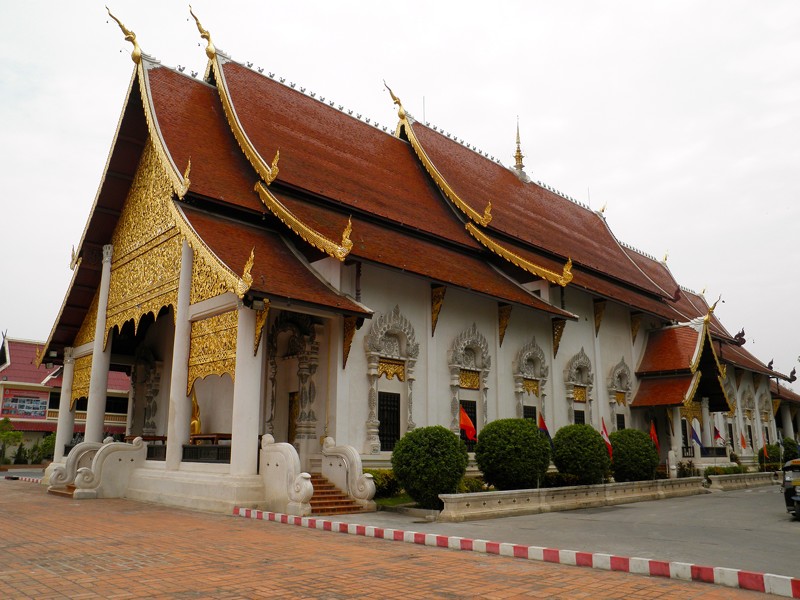 One of the Buddhist temples we toured in Chiang Mai.
There are as many Buddhist temples in the greater Chiang Mai area as there are
protestant churches in Calloway County, Kentucky - a grand total of 130.
Like all building structures within a specific faith, the architecture
is similar. One temple looks much like another, but all are spectacular
with their colorful tile peaked roofs, gold paint trim and
intricate carving.
 The entrances to most Buddhist temples are guarded by a
pair of nagas (dragons) to ward off evil spirits. I love the way the tails
of these two intertwine perfectly over the doorway.
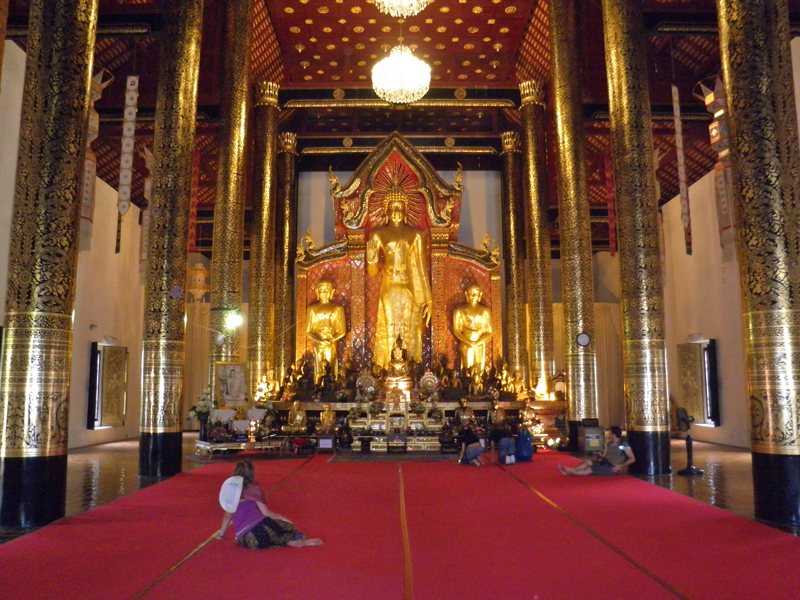 Inside one of the temples. The trick is to leave your
shoes outside, be sure to lower yourself so you are never at a level higher than
the main Buddha image, and fold your legs to the side when sitting so (major
taboo!) your feet don't point in Buddha's direction. Don struggled
with this particular position, so did his best not to approach the
Buddhas too closely such that his tall self wouldn't
offend.
 Another temple and lots of Buddhas. The devout are
lighting joss sticks and paying their respects. Just to the
left is a monk going about his business. We saw a few monks, but
generally we were warned to keep our distance from
them so as to not distract them (this advice was targeted more toward
women, particularly younger women). It's also in good taste for both men
and women to dress modestly when visiting temples with shoulders,
elbows and legs covered. Near the entrance of some of the more revered
temples were 'dressing rooms', where those who were not dressed modestly
enough were gently corralled and rented sarongs to drape around naked legs or
shoulders. It was all very civilized and understandable. We were
just grateful that all the Buddhist temples were open to tourists and most even
allowed photos inside. The little bit we know about Buddhism indicates
it's a very open and welcoming religion. It's a good thing too since
the pageantry is so amazingly over the top - it would have been a pity to
miss.
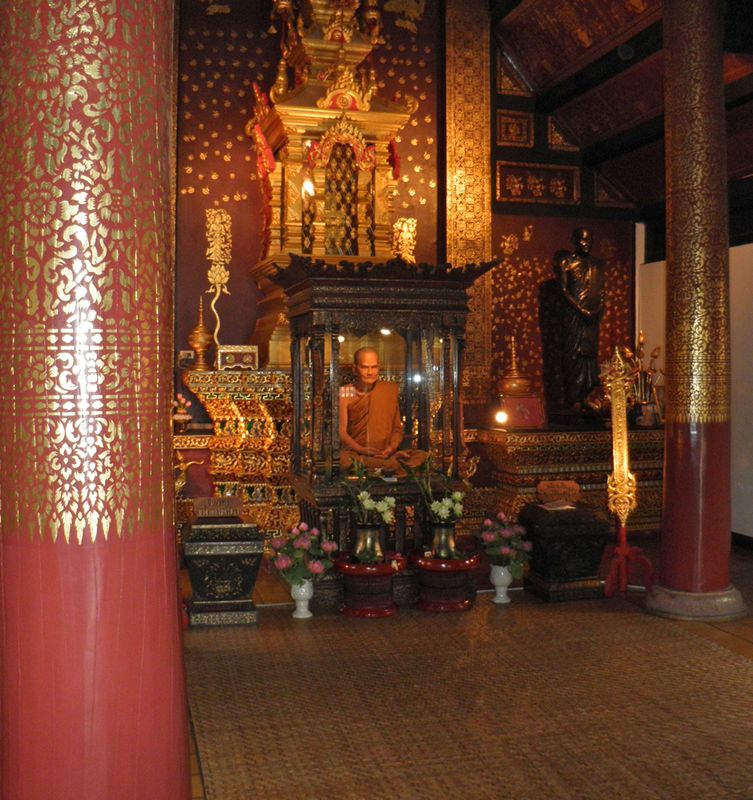 Yes, this is a monk. A monk in a glass box. He's
not alive, but he's not dead either. It's a wax model of a
renowned abbot of the temple. He is deceased (and was cremated), but
this shrine was built to honor him and some (all?) of his relics (ashes,
bones) are kept here.
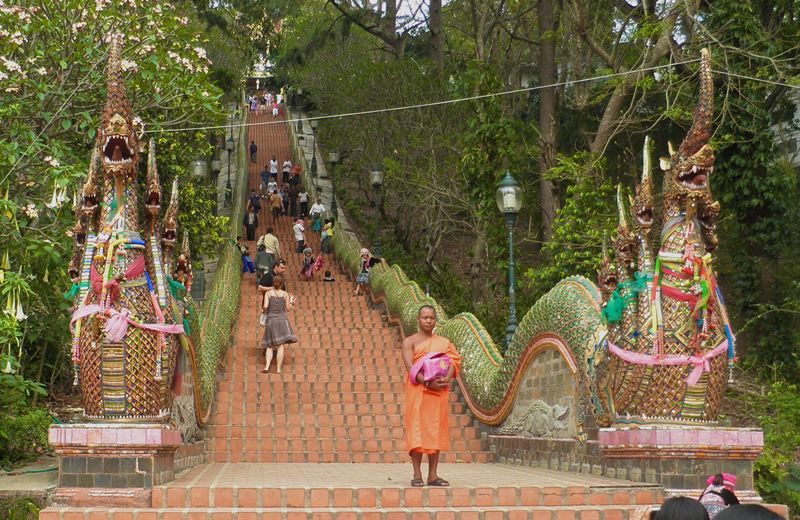 This is the entrance to one of Chiang Mai's most important
temples (or wats as they are called in Thai). Guarded by a pair of
seven-headed nagas, whose tails reach the full length of the 307 step staircase,
this temple sits on a mountain side overlooking the city of Chiang Mai.
The temple was built on this particular spot starting in 1383 because a
prominent monk from Sukhothai (south of Chiang Mai) instructed the local Lanna
king to enshrine a very important relic (religious item - usually bone or ashes
from an important figure, sometimes claimed to come from Buddha himself)
somewhere on the mountain. The king strapped the relic to the back of a
white elephant (albino elephants were considered extremely valuable, and were
the monarchy's travel mode of choice - which was true as recently
as the early 20th century), and proclaimed that
wherever the elephant stopped, a temple would be built. The elephant not
only stopped on the mountain, it died, and Wat Phra That Doi Suthep was
built.
By the way, we were happy to see that monks get to
sightsee too. This one posed while his family snapped
pictures.
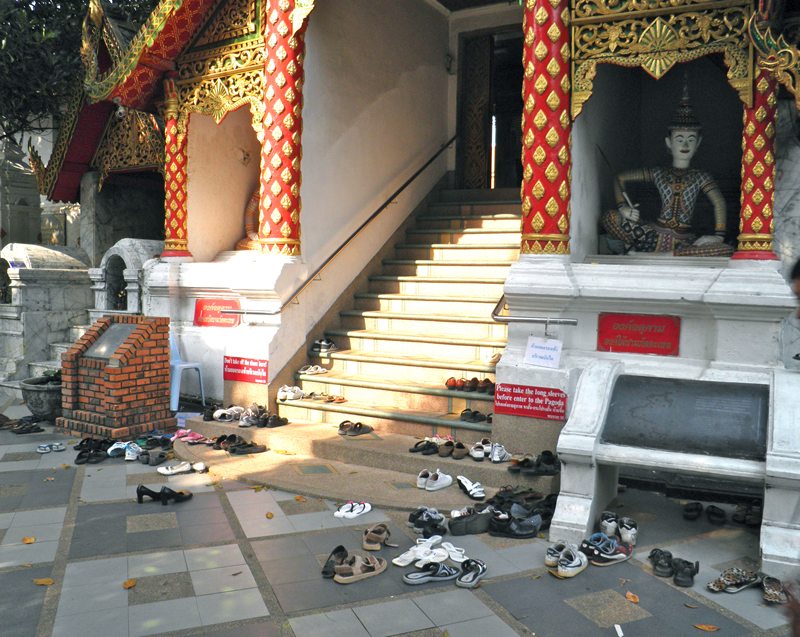 Shoes. A common sight outside all Buddhist
temples. Sometimes we had to laugh because there were segregated shoe
racks outside of several temples we visited. One rack for Thais, one for
foreigners. We weren't sure why the shoes had to be segregated, but
complied anyway just to be sure we didn't offend Buddha.
 Dancing Thai girls on the grounds of the mountainside temple
(Wat Phra That Doi Suthep).
 Wat Phra That Doi Suthep. Aside form the Grand Palace in
Bangkok, this was the most crowded temple we visited. Packed with Thai and
foreign tourists alike, the place was buzzing. It definitely wasn't the
serene, meditation-friendly atmosphere you might normally associate with
Buddha. But....it was gorgeous. Impossible to photograph
though. The compound contained at least six buildings, all beautifully
constructed and decorated with gold. The umbrella-like structure in the
center of the photo represents the tree Buddha sat under when he achieved
enlightenment. The tall, gold structure to the right is the 'chedi' within
which the relic the white elephant delivered is
enshrined.
In total we visited six or seven wats (temples) in the
Chiang Mai area. Each one was more fantastic than the last and each has
its own unique history - some dating back to the 13th century. Most of the
opulent gold-covered structures were built with teak logging, and possibly
opium, money. Today, both industries are banned - one to protect the
forests, the other to protect humankind. Teak logging wasn't banned until
more recently, and one of the fallouts has been out-of-work elephants.
Really. For centuries, man and elephant worked together to log teak,
but no more. It used to be that a father and son mahout (elephant
keeper/trainer) team would work with a single elephant for all their
lives. The father/son team was needed to span the lifetime of an
elephant. Today the elephants have nothing to do but entertain
tourists. In Bangkok it's said that it is not uncommon to see an
unemployed elephant wandering the streets (we didn't, but others have).
The one thing we didn't get to do in northern Thailand was to go see the
elephants. The two options close to Chiang Mai seemed too touristy to us,
and we couldn't get a hotel room near the elephant place further
outside of town. Maybe next time. Elephants are such an integral
part of Thailand's history it seems a shame not to pay homage. After
reading some of the history, I'm still having visions of ancient battles fought
by warriors sitting atop herds of elephants - it seems more like
something you might read in a fantasy novel than real history.
Cool.
 Now the cooking part. Based on encouragement received
from friends that had gone before us, we decided to go for a half-day Thai
cooking course. Yes, both of us. Don and I, a French Canadian, three
Swedes, a woman from Idaho and a UK couple braved the world of Thai cooking and
each made an appetizer, soup, noodle dish, curry paste and curry dish.
Don's Penang curry was voted best dish (by me, anyway), and his sexy soup was no
slouch either. Our teacher, the tiny Bai, belted out
instructions ("Start the fire! Add water! Fish sauce!
Oyster sauce! Hotter! Vegetables! Stop cooking!) while
nine of us sweated over woks on gas burners. We pounded dried chili
peppers and spices into submission with a mortar and pestle to make the curry
paste (that's me demonstrating my curry paste cooking abilities above).
The flavors and spices were so intense that when we all fired up our curry
pastes we could barely breathe (in a good way), coughing and spluttering all
over our curry. It was still good though. After eating so much Thai
food over the past three months, Don and I have a new found tolerance for hot
peppers. You'll see. When we are home this summer, we'll cook Thai
for you and dare you to eat it.
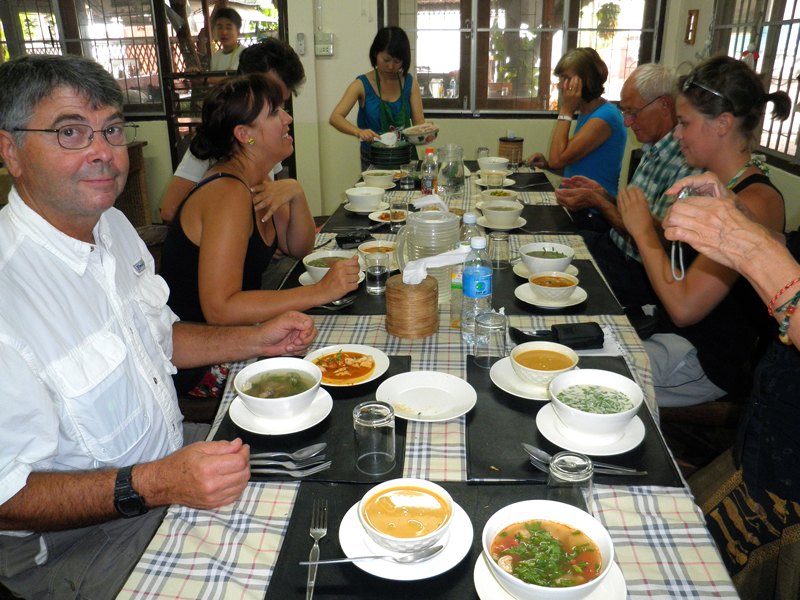 The final product. Don with his Penang curry and sexy
soup along with our fellow international chefs (and our instructor Bai standing
at the end of the table dishing up rice).
 And...last but not least, the market. Tipped off by the
Maloneys based on their travels here before us, we ventured out for the Sunday
night 'walking street'. The main street through Chiang Mai's old city is
blocked off and hundreds of vendors set up shop for the duration of the
evening. Silk, silk, lots of silk (this is part of the famed silk trade
route, after all), embroidery, leather goods, wood carving, paintings, on and on
and on. It was so overwhelming we decided we might have to go back and do
it all over again just to be sure we didn't miss anything.
That's it for our four days in Chiang Mai. Sorry for the
long entry, but Chiang Mai was so packed with cool stuff and
experiences (including the quake) it's hard not to overdo it.
Anne
|